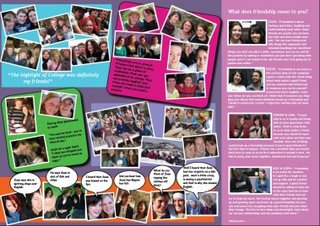autobiographical comics
I put this autobiographical comic together in one day (yesterday) and thought I would share it and the making of it with you....
Why do it?
I was browsing for interesting art curriculum and came across a great site which uses exemplary work of artists working with students.
An autobiographical comic project by Heather McAdams caught my interest. It is based on encouraging students to write autobiographies about particular moments, events, emotions. She has a list of questions to get them thinking of a range of stories and they then choose a particular story. They then look at what images might go with their story and how to exagerate emotions and events - emphasising emotional highs and lows, and using metaphor and symbols to make the imagery more intense. They then look at creating a comic (1 or 2 pages) using 8 to 16 panels - they don't need to be uniform. Good drawing is not required. The website has a thorough descriptor of her process, her questions to invite stories and tips for comic making.
I am a real fan of autobiographical writing methods - it was one of my own research methods in my PhD. It can be extended by looking at the cultures which might be embedded in the story and which shape the moment. So personal stories can be value added by some navel gazing.
Anyway, as with all new things I thought I would have a go and see how easy it would be. I admit to already being a cartoonist - have a book published - and was a cartoonist for a publishing company. My style is very different to McAdams. Clean lines. Single or triple panels. But the multi-panel A4 page requires a different look. Needs a lot more variety - and McAdams suggests using hatching and dots to create different shades, textures and lighting effects.
The process
.jpg) OK, so what story do I have? Well one comes to mind - it was my graduation day on Saturday ... which I missed. Could there be a story in that? It was pretty easy to write some lines, putting myself into the present moment. It is interesting that when thinking of text for the purpose of a comic it does shape the rhythm and linking of sentences. As you write images start suggesting themselves. I needed think time between doing it - this added extra depth and enabled me to reflect on the deeper meaning, and during all stages of the process this think time was important.
OK, so what story do I have? Well one comes to mind - it was my graduation day on Saturday ... which I missed. Could there be a story in that? It was pretty easy to write some lines, putting myself into the present moment. It is interesting that when thinking of text for the purpose of a comic it does shape the rhythm and linking of sentences. As you write images start suggesting themselves. I needed think time between doing it - this added extra depth and enabled me to reflect on the deeper meaning, and during all stages of the process this think time was important.Now it is time to draw a mockup on paper. Modify, improve, refine and minimise text, maximise the ability of the images to tell the story, can I use a metaphor? Now do a proper copy on bleedproof paper with black felt tip pens.
So now I have two comic A4 pages. Pretty good.
But because I have been playing with moviemaker I wondered how successful using static pictures might be in a movie. Digital Storytelling techniques suggest using autobiographical stories and voice overs to go with photos - but can it apply to comics as well? The voice overs connect directly to the uniqueness and the emotions of the person and their experience and helps the story connect with the audience - creating a sense of empathy and causing them to reflect on their own stories.
My husband has been playing around with crazytalk which takes static pictures of people and enables you to animate the face and put in lip synch as you do a voice over. So I drew a cartoon especially to try that. And then I put all the comic pics and the crazytalk movie into movie maker for editting and voice over.
I can just imagine student potraiture art work animated to tell their stories.
I really enjoyed the process, and it helped me reflect on my whole experience of my missed graduation day. So it was useful as personal therapy but does it have a wider audience? Can telling our personal stories in such a way touch others? You decide....
Labels: autobiography, comic, crazytalk, storytelling









